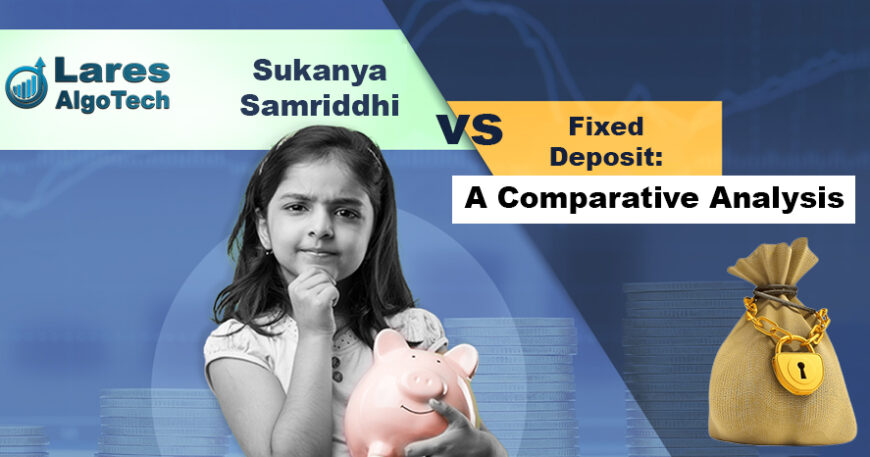Sukanya Samriddhi and Fixed Deposits are two of the most popular investment options that are a part of financial planning. Sukanya Samriddhi is a government-backed savings scheme for the girl child where parents can save for their daughter’s future expenses like education and marriage.
On the other hand Fixed Deposits are a common investment option offered by banks and financial institutions where you can earn fixed returns on your invested money for a fixed period. Both these investment options are important tools for long-term financial planning to achieve your financial goals and secure your future. In this blog, Sukanya Samriddhi vs Fixed Deposit we have analysed all the important aspects. This will help you know about these two investment schemes in a better way.
Features of Sukanya Samriddhi
Eligibility:
Sukanya Samriddhi Yojana is available for parents or guardians of a girl child below 10 years of age. Only one account is allowed for one girl child and a maximum of two accounts can be opened for two girl children in a family.
Tax Benefits:
Investments in Sukanya Samriddhi Yojana are eligible for tax benefits under Section 80C of the Income Tax Act. Interest and maturity amounts are tax-free.
Interest Rate and Maturity:
The interest rate for Sukanya Samriddhi Yojana is revised and notified by the government every quarter and is compounded annually. The maturity period of the scheme is 21 years from the date of opening of the account or until the girl child gets married after 18 years of age.
Features of Fixed Deposits
Fixed Deposits, commonly known as FDs, are a common investment option offered by banks and financial institutions. When you invest in a Fixed Deposit, you are depositing a sum of money with the financial institution for a fixed period at a fixed interest rate.
Interest Rates: Interest rates on Fixed Deposits vary from bank to bank and depend on the deposit amount and tenure. Generally Fixed Deposits have higher interest rates than regular savings accounts.
Tenure: Fixed Deposits have flexible tenure options ranging from a few days to several years. Interest rates may vary depending on the Fixed Deposit tenure.
Liquidity: Fixed Deposits are considered stable and secure investments but are less liquid than some other investment options. Generally, premature withdrawal of a Fixed Deposit may attract a penalty and reduce the interest earned.
Tax: Interest earned on Fixed Deposits is taxable as per the investor’s tax slab. This interest income is added to the investor’s total income and taxed accordingly. If interest income crosses a certain limit TDS (Tax Deducted at Source) may apply.
Overall Fixed Deposits are a secure investment with fixed returns and are suitable for those who want to preserve capital and get a steady income.
Comparison: Sukanya Samriddhi vs Fixed Deposit
There are some important key points in the topic of Sukanya Samriddhi vs Fixed Deposit. Read these key points carefully so that you have a better idea about these two investment schemes
Interest Rates:
Sukanya Samriddhi Yojana has competitive interest rates which are revised and notified by the government every quarter. Interest is compounded annually and the scheme has attractive interest rates.
Fixed Deposits have varying interest rates across different banks and depend on the deposit amount and tenure. Generally, interest rates for Fixed Deposits are higher than regular savings accounts and give good returns.
Risk Factors:
Sukanya Samriddhi is a government-backed scheme so it has a higher level of security as it is guaranteed by the government. The scheme is low risk and gives stable returns for future expenses of the girl child.
Fixed Deposits are also low risk as they give fixed returns on the invested amount. However, risk is associated with the bank’s stability and reputation. It is necessary to choose a reputed bank or financial institution to minimize this risk.
Liquidity and Flexibility:
Sukanya Samriddhi has specific withdrawal rules and is designed to give returns for future financial requirements of the girl child especially for her education and marriage. It has a long maturity period and limited flexibility for premature withdrawals.
Fixed Deposits have flexible tenure options and investor can choose the tenure as per their liquidity needs. But premature withdrawal of Fixed Deposits may attract penalties which will affect the overall returns. It has more liquidity than Sukanya Samriddhi but with a penalty for early withdrawal.
Advantages of Sukanya Samriddhi Yojana
- For future financial needs of the girl child, education and marriage expenses.
- Tax benefits under Section 80C of the Income Tax Act.
- Competitive interest rates are revised and notified by the government.
- Government-backed scheme so higher level of security and stability.
Disadvantages of Sukanya Samriddhi Yojana:
- Long maturity period and limited flexibility for premature withdrawals.
- Only for parents or guardians of a girl child below 10 years of age.
Advantages of Fixed Deposits:
- Flexible tenure options from a few days to several years.
- Higher interest rates than regular savings accounts.
- Fixed returns and low-risk investment.
Disadvantages of Fixed Deposits:
- Premature withdrawal may attract a penalty which will reduce overall returns.
- Interest earned is taxable as per the investor’s tax slab.
- Risk associated with the bank’s stability and reputation.
Conclusion Remarks
Depending on the financial goals and needs, Sukanya Samriddhi Yojana may be better suited for parents looking to secure funds for their daughter’s specific future expenses while also availing tax benefits. On the other hand, Fixed Deposits may be a better option for individuals seeking stable returns with the flexibility of choosing various tenure options. So this was the complete analysis of Sukanya Samriddhi vs Fixed Deposit. The choice between the two depends on individual financial goals, risk tolerance, and the specific need for the funds.





